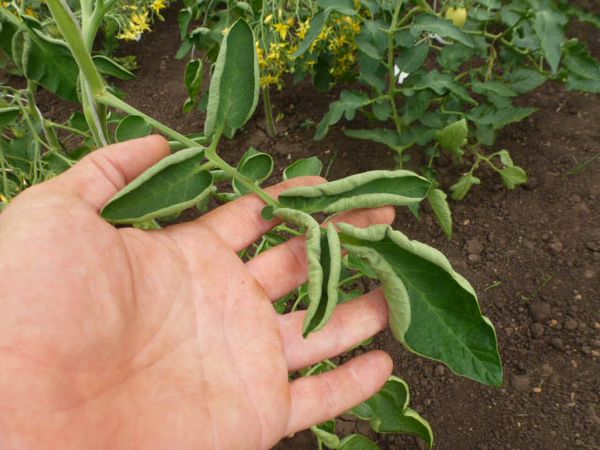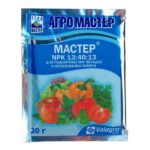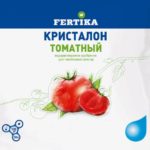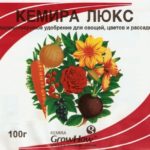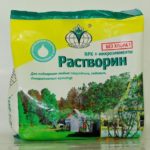The problems associated with the deterioration of the quality of life of any organism, primarily affect its appearance. Very eloquently the distress signals manifest themselves on plants. For example, when there is a shortage of potassium, tomato leaf necrosis begins.
In the article we will talk about the signs of a lack of any elements and how to feed the plant to improve its condition.
Table of contents
- Lack of trace elements in tomatoes
- Magnesium deficiency
- Use of magnesium fertilizers
- Phosphorus deficiency
- Application of phosphate dressings
- Lack of potassium
- Application of potash supplements
- Boron deficiency
- Use of boric acid
- Lack of nitrogen
- Nitrogen Fertilizer Application
- Zinc and magnesium deficiency
- Complex multicomponent fertilizers
Lack of trace elements in tomatoes
The deterioration of the state of the plants most often lies in the lack of (less often - excess) nutrition. What kind of dressing waiting for tomatoes, you can determine by nature and location of changesoccurring with the plant.
A wide range of microelements is vital for tomatoes:
- Magnesium.
- Phosphorus.
- Potassium.
- Nitrogen.
- Zinc.
- Bor and others
Without them, the plants will not die, but will develop much worse, crop yield significantly reduced. All of them are catalysts that accelerate biochemical reactions in plant tissues.
Magnesium deficiency
Magnesium deficiency manifests itself in appearance spots between the veins on the bottom tomato sheets. Initially, these spots look light green, then turn yellow, and then become brown or gray. The leaves dry, curl up, then fall off. Fruits are small, poorly ripen.
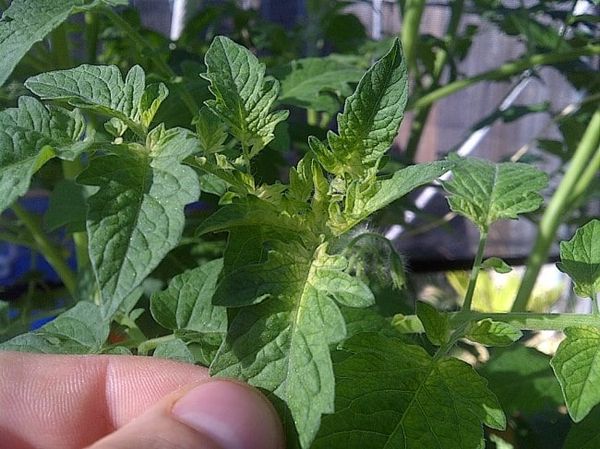
Use of magnesium fertilizers
Magnesium sulfate is used at different stages of culture growth.
- Soil preparation. Fertilizer is made at the rate of 10g per 1 sq.m. and then watering the beds copiously.
- During the growing season. For irrigation, 30g of fertilizer must be diluted in 10l of warm water (use 2 times a month). When spraying 15 g of the substance is dissolved in 10 liters of warm water. In order not to burn the leaves, add 5 g of urea to the solution.
Phosphorus deficiency
When phosphorus deficiency occurs weak root system. The aboveground part of the plant acquires a dark green color, which later becomes purple-violet. The leaves are hard, their edges dry.
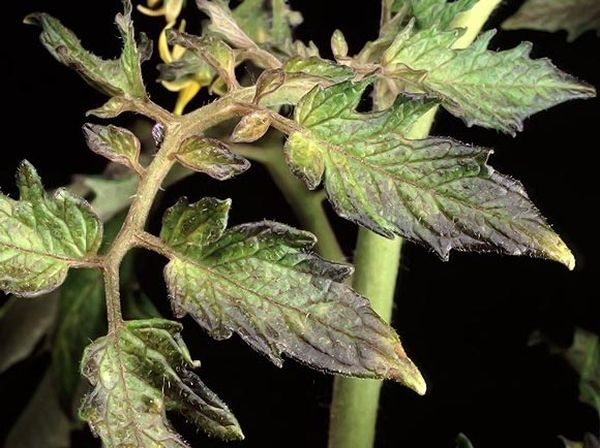
Application of phosphate dressings
Fertilizer contributes to the development of a powerful root system, increase yields, improves the taste of fruits. Bring it before the end of the flowering period.
Dry matter is buried in the ground at the rate of 15-20g per plant. For root dressing prepare the hood.
- In 3 l of boiling water, add 400 g of superphosphate.
- Keep the solution warm, stir occasionally to achieve complete dissolution of the powder.
- In a day the liquid will turn white. Now you can use it.
Then 20 tablespoons of the extract diluted in 3 liters of water.The main fertilizer is prepared from this working infusion (150ml of the obtained liquid + 10l of water + 20g of nitrogenous fertilizer + 0.5l of wood ash).
Lack of potassium
Lack of potassium is expressed in slowing the growth of a tomato bush, its poor flowering and a small amount of ovary. Fruits ripen unevenly, often remaining immature near the stem.
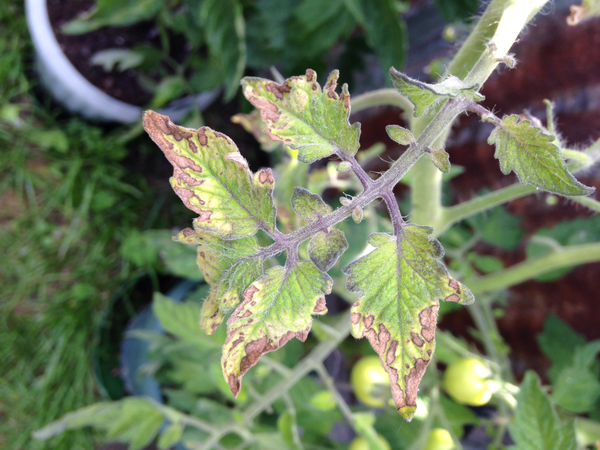
Leaf necrosis starts from their tips, gradually spreading around the perimeter. Soon there are brown spots. After a time, the leaves curl and fall. The stalk becomes weak, fades.
Application of potash supplements
- Potassium sulfate (potassium sulfate) is applied on alkaline soils. With dry use per 1 square meter, the beds contribute 40g of this feeding with an interval of 10-15 days. For irrigation, 1 g of substance is dissolved in 10 l of water.
- Potassium monophosphate. It is well dissolved in water. Used for root and foliar feeding. It is applied 2 times for the entire growing period (after transplanting and during the ripening of the fruit). For irrigation dissolve 10-15g of fertilizer in 10l of water.For spraying 1-2g substances dissolved in 1l of water.
- Potassium Nitrate (potassium nitrate). The period of use - the formation of the ovary. Dry matter is highly soluble in water. For irrigation, dilute 10-20 g of powder in 10 liters of water. For spraying, 10 g of saltpeter is dissolved in 10 l of water.
- Potassium humate. Receive from the remains of vegetation, manure, peat, silt. Best used on alkaline, saline and podzolic soils. The period of use is the time of intensive growth of the culture. For spraying or watering 3g (1 teaspoon) of the substance is dissolved in 10 liters of water. Fertilize plants 3 times for the entire period of cultivation. The interval is 2 weeks.
Boron deficiency
With its lack of seedlings are developing poorly. The bush is happening dying out of the growth point, but side shoots grow actively.
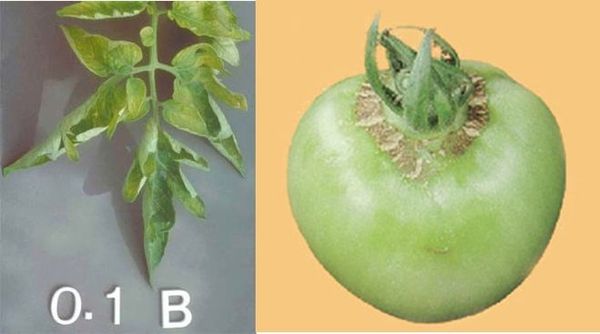
Flowers fall off, little ovary is formed. Productivity is low, while dry spots appear on fruits. Sheets curled into tubes, become light green in color.
Use of boric acid
For watering 5g boric acid dissolved in 10 l of water. But best of all boron is absorbed by the plant when foliar feeding. For spraying 10 g of boric acid must be diluted in 10 liters of water.The solution is used warm.
Tomatoes are detrimental both deficiency and excess of boron. Spraying is carried out once, during the mass flowering of plants.
Lack of nitrogen
Lack of nitrogen leads to chlorosis. Leaves become small, thin. The color of the vein and sheet plate is converted from green to light red. Old leaves turn pale, then turn yellow, and finally acquire a yellow-white color. The stem hardens, acquiring a red tint.
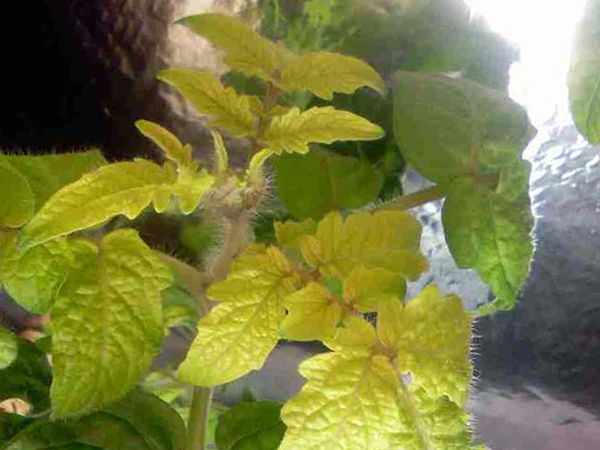
Nitrogen Fertilizer Application
The mixture for entering into the soil consists of 9 liters of manure (liquid), 25 g of dry saltpeter, 80 g of wood ash. Then the beds are abundantly watered. The first feeding is carried out 10 days after transplanting. The second - after 10 days.
Zinc and magnesium deficiency
Shortage of zinc is expressed in the spread on the sheet plates gray-bronze spots. Plots of tissue die over the entire surface of the sheet. Young leaves shallow, covered with yellow specks, take a slightly upright position.They become asymmetrical, twisted.
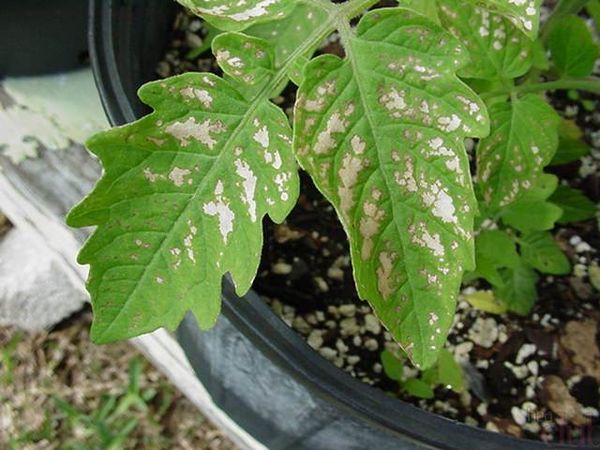
For foliar top dressing 5g zinc sulphate dissolved in 10 l of water.
Magnesium deficiency begins to manifest on the lower leaves. The veins remain green, and around them there is yellowing, then a slight reddening of the leaf tissue, the appearance of a violet hue is possible. The border of the leaves is bent upward, giving them a dome-shaped bend. Magnesium chlorosis occurs more often on acidic soils.
Applied foliar top dressing. In 10 liters of water dissolve 1 teaspoon of magnesium nitrate, which will replace the English salt.
Complex multicomponent fertilizers
Manufacturers always indicate fertilizer composition on packaging, quantitative content of one or another component.
The instructions are painted dosages and methods of use chemicals. The advantage of these drugs - ease of use and high efficiency.
- Master - Accelerates growth, helps harmonious development of roots. It is brought in soil at the rate of 100-150g on 1 sq.m.
- Crystal - Dilute 10-20g of substance in 10l of water. Used for watering in greenhouses - every time, for watering in open ground - 1 time in 2 weeks.For spraying, dissolve 10g of the substance in 1l of water and spend it once a week.
- Kemira Lux - 20g dissolve in 10l of water.
- Mortar A - For watering 10-25g means dissolved in a bucket of water. For spraying, 25 g of the substance is dissolved in 10 liters of water. Fertilizer is used once a week.
- Master
- Crystal
- Kemira Lux
- Mortar A
Required condition - security measures. Do not inhale vapors of solutions or dust formed by dry substances. Gardeners work in respirators and clothing, preventing the ingress of chemicals to open areas of the body.
It is necessary to mix components for receiving fertilizer with full confidence in a correct dosage.
